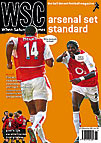 With China beckoning, Paula Cocozza checks on the development of England's feminine side
With China beckoning, Paula Cocozza checks on the development of England's feminine side
When the whistle blew on England’s 1-0 win over Iceland at St Andrews on September 22, the coaching staff and subs ran on to the pitch and the players hugged each other as one. It was the way almost every positive result that had taken them this far – to the brink of the 2003 World Cup in China – had been greeted. In the press room afterwards the England manager Hope Powell searched for the right words. “I think it’s… it’s relief,” she said.
Not just because Amanda Barr waited until four minutes from time before scoring the goal that secured a 3-2 aggregate win, having missed the most welcoming of open goals more than an hour earlier, but because making it to China was never a likely project. Only five European teams out of 16 qualify, and more than five teams in Europe are currently a good deal better than England. One of those teams, France, will be visiting in October for the first leg of the play-off final, the last obstacle between Powell’s side and China.
This has never been just a World Cup campaign, but a promotional one too. Three years ago, reaching the 2003 finals was identified as crucial to the FA’s plans to launch a professional women’s league, which had also been pencilled in (though subsequently smudged out) for the same year.
It was on the back of the national side’s triumph in the 1999 World Cup, and the victory tour that followed, that the United States managed to lure the millions of dollars it needed to set up WUSA, the professional league that has just completed its second season. However, even if England do make it to China, nothing short of a miracle would bring them success of that kind; or even, some would say, take them beyond the first round.
England’s status on the world stage is still such that their presence in the eight-team European Championship last year was hailed by all concerned as a triumph in itself. Getting there was, Powell said even before her side boarded the plane to the finals in Germany, a tremendous achievement. Rather than 2003, the more realistic target is now set at 2007 – the year the FA identified, at the opening of its International Player Development Centre in Loughborough 12 months ago, as the one in which England would be crowned world champions.
The Loughborough centre was instituted partly to deter the country’s most promising talent from seeking similar scholarships overseas, and partly to try to catch up with the most powerful nations of the women’s game – China, the US, Norway, Germany and Sweden. But in the early stages of its conception, the project was inspired by somewhere closer to home – just across the Channel, in fact, where England will soon be travelling for the second leg of their play-off final.
It was on a visit to Clairefontaine, the French national training centre, that Powell and her team refined their plans for Loughborough. Clairefontaine, of course, has churned out dozens of male stars, including Thierry Henry and David Trezeguet. Three years ago it opened its doors to the women of France and – stop me if you’ve heard this one before – declared that its goal was to win the World Cup in 2007. Already there are signs of improvement in France, as Powell’s scouting aides will have noticed on their visits in preparation for next month’s crunch match.
It is notoriously hard to gauge the relative strengths of women’s teams that rarely play each other. The fact that England have not beaten France since 1974 is not as telling as it may sound, since standards have changed so dramatically and unevenly in recent years.
A more reliable form guide may be the results of France’s play-off semi-final in which they beat Denmark 3-1 on aggregate – a noticeably more impressive achievement than England’s struggle with outsiders Iceland. Last year, when Denmark came to Northampton’s Sixfields ground for a friendly, they humbled England with a comprehensive 3-0 win. That 2007 ambition still looks a long shot.
From WSC 189 November 2002. What was happening this month